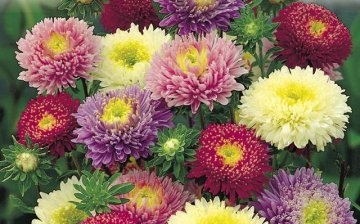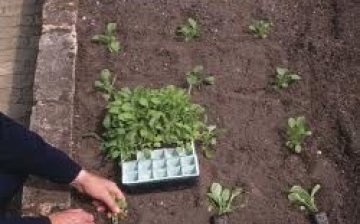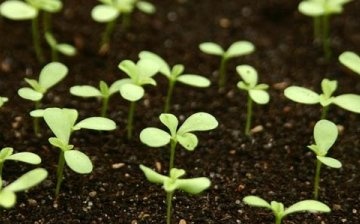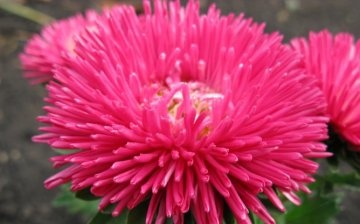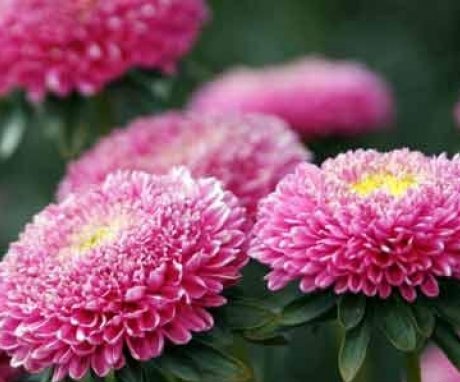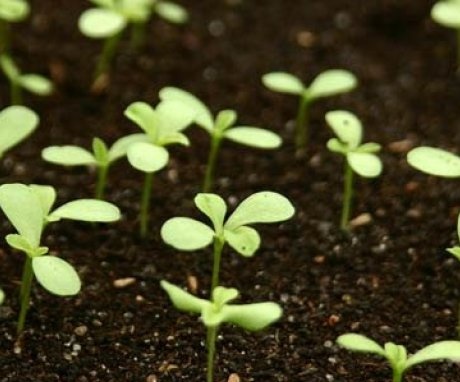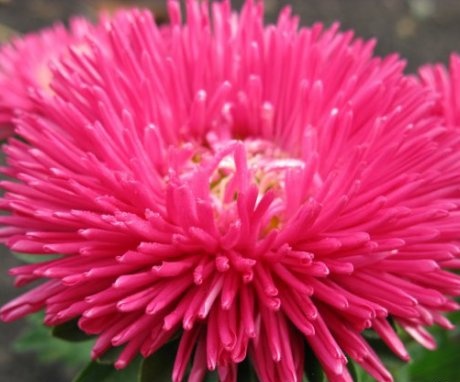Asters: growing and breeding
The noble aster is shrouded in myths and legends. The most romantic of them is about the origin of the plant. Tradition says that shooting stars, barely touching the ground, turned into bright flowers of amazing beauty. And, the more asters grow, the more often secret desires are fulfilled.
One can only guess what many dream about, peering into the night starfall. Although one of the wishes of gardeners is quite predictable: to grow the rarest and most spectacular types of flowers on their site. Our article is devoted to how you can "pick up stars from the sky" and breed your favorite varieties in your garden, how to properly care for and protect them from pests.
Content:
Types and varieties of asters
Find your way and choose the right one type of flower variety not very easy. There are so many varieties of aster that official plant classifications have long been developed and adopted.
According to one of them, asters are divided into three types, ten types and more than forty series of varieties. The main difference is the shape of the flower.
By the name of the type of aster, you can imagine inflorescence appearance... Within each series of varieties, plants differ mainly in the color of the petals. You can choose the right flowers for the purpose of the variety.
Plant types are divided into:
- Casing.
- For cutting.
- Potted.
- Universal.
There are perennial and annual plant species.
When choosing a variety, you can focus on the height of the flowers. They are both tall and completely dwarf, creeping along the ground.
The most popular varieties and series of varieties:
- Ray aster Delight. Long standing in a bouquet.
- Astra Andersen. Low-growing type of plant.
- Alpine aster. Looks good in mixed flower arrangements. Differs in abundant and long flowering.
- Royal aster. Has a dwarf size.
- Mongolian aster. Grows up to one meter in height. Lavender flowers.
- New Belgian asters. Suitable for border decoration. Popular for its late flowering period.
- Italian aster. The flowers are purple and pink.
- Astra Thompson. A perennial species of asters with blue petals.
In the composition of autumn landscape design, these flowers act as the main color spot. Usually, asters are not used individually. Plant plants in groups and mixed arrays, choosing suitable neighbors. The most advantageous option would be to plant several varieties of flowers together. For example, tall with dwarf, needle-like with tubular. Ensembles of asters of different shades look spectacular.
Plants can be supplemented with chrysanthemums, anemones or mountaineer stalk. Such neighbors will hide the bottom and set off the bright hats of asters. Ornamental cereals are suitable for them.
It is for the diversity and versatility that asters have gained popularity among garden flower lovers.
Care features
Asters thrive and bloom luxuriantly in places with good access to the sun. Despite the need for an open, unshaded area, reliable protection against drafts should be considered.
Important for flowers:
- Drainage of soil.
- You can plant asters on an area where marigolds, calendula, or perennial herbs grew before.
- Avoid planting crops in places where carnations were grown, gladioli and tulips.
- The optimum temperature for flowers is considered to be 16 degrees Celsius.
- Humidity is about 65%.
- In extreme heat and drought, the quality of the inflorescences decreases. Part of the seed harvest is also lost.
- Contraindicated for asters: permanent dampness, relatively shallow groundwater and too high soil moisture.
- Despite the fact that asters can be classified as a type of plant with increased drought resistance, during prolonged heat, abundant watering should be provided. It is especially important to monitor the quality of watering during the budding period.
Like other plant species, asters need feeding for abundant and long-lasting flowering:
- At the first stage, when digging in the fall, humus is added to the soil.
- Then fertilizers are applied through two weeks after transplanting seedlings.
- You can feed the flowers again at the moment when the buds are tied and blooming.
- In this case, the fertilizers should not contain nitrogen.
- Mineral-based mixtures should be chosen, avoiding the use of organic substances.
The advantage of the plant is that it is resistant to night frosts.
When other flowers are already ready for wintering, autumn perennial aster varieties turn into dense bushes covered with large flower caps. The flowering period is about six weeks.
Asters are finicky in their choice of soil. They prefer fertile, sandy loam and loamy soil. In the spring, you need to mulch the soil around the stem of the plant. You should not plant annual asters in one place for two seasons in a row - the likelihood of infection of the bush increases.
Astra belongs to an unpretentious type of horticultural crops.
Subject to the basic rules of care, until winter, the grateful plant will delight the owners with lush flowers, from which you can create luxurious autumn bouquets.
Reproduction of asters
Asters can be diluted either by sowing seeds or by seedlings.
Seeds are sown in spring or before winter. Seedlings are prepared in a greenhouse or in an apartment.
Sowing substrate should ideally consist of:
- Leafy land.
- Sod part.
- Peat.
- Sand.
- Lime.
- Superphosphate.
Consider the technique propagation by seedlings.:
- The mixture must be disinfected by pre-calcining in the oven and spraying with a solution of foundationol.
- Seeds are sown after March 15th.
- If you need to plant them earlier, then you need to carry out additional lighting.
- Sprinkle the planting material with sand or sifted earth.
- It is better to treat the seeds before sowing with a fungicide.
- Do not forget to put up label boards if you plan to plant several varieties at the same time.
- The sown seeds are sprayed with water, and the containers with soil are covered with foil.
- After germination (usually after 5 days), the boxes are moved to light.
- If young shoots have begun to stretch out strongly, you need to add disinfected sand to the soil.
- When the first leaves appear, the shoots dive one by one into small pots with a diameter of 5 cm or into special containers for seedlings.
Seedlings are grown at a temperature of 15 degrees, providing intense lighting:
- If there is a lack of light, you can use lamps, placing them at a distance of 50 cm.
- It is necessary to illuminate the seedlings continuously, for 14 hours a day, following the constant schedule of turning on and off the lamps.
Eight days after the pick, you need to start feeding the seedlings:
- Urea will do.
- The seedlings are then fertilized once a week.
It should be noted that seedlings develop quickly and tolerate transplantation well. The main thing is to prevent thickening of the planting and ensure good watering.
Do not overdry young bushes and flood them too much. The seedlings are hardened three weeks before planting. To do this, it is necessary to take young plants out into the open air. So the plants will be able to tolerate frosts down to minus 5 degrees. Asters are planted in open ground in May.
After transplanting, the seedlings are watered and mulched.
With seed propagation prepared material sown in warm soil in early spring.It is required to cover the beds well before the first leaves appear.
You can sow aster in the winter. This should be done at a time when the soil is frozen. Thinning in this case is transferred to the spring. The advantage of the winter method is that the flowers are less likely to become infected with Fusarium.
Growing problems
Unfortunately, asters get sick a lot and are susceptible to pests:
- One of the most common diseases is root rot or fusarium. For the prevention of disease, asters are treated with copper, a solution of sulfuric acid salts with zinc or magnesium.
- Diseases of fungal origin are dangerous for flowers. For example, powdery mildew. A symptom of the disease is the appearance of a white-gray bloom on the leaves of the plant. The causes of damage are usually the wrong composition of the soil, rare watering or untimely transplantation. At the first signs of damage, asters are sprayed with sulfur-containing preparations.
- Late blight caused by a fungus is dangerous for the plant. The affected area of the aster is covered with brown spots with a white coating. In this case, treatment with copper preparations is recommended. Frequent weeding and careful destruction of the remnants of rotten stems will help prevent infestation.
- Of the pests, caterpillars should be especially distinguished, which eat up leaves and bud aphids, which are dangerous for seedlings. Phosphamide, karbofos and chlorophos will help in the fight against insects. It is also important to loosen the soil, weed out weeds and remove plant debris.
- Asters also suffer from spider mites. Typically, parasites attack in dry and warm weather. In such cases, the flowers are watered with onion infusion.
- If slugs are found on the flowers, sprinkle the bushes with lime and superphosphate. Then the soil is loosened.
- Insects are also carriers of diseases. So, cicadas can infect asters with the cucumber mosaic virus. The leaves begin to brighten, shrink and deform. The causative agent remains in the rhizomes of flowers. You cannot save an infected plant. You can only prevent infection of neighboring bushes by immediately digging up and destroying the affected specimen.
- Aster is not very resistant to bacterial diseases. If a bacterial spot is found, manifested in the form of oily spots on the stems and buds, treatment with copper chloride is carried out.
To prevent the occurrence of most ailments, it is important to thoroughly disinfect the working tools, substrate and planting material.
Despite the problems of cultivation, asters have firmly taken root in the areas of gardeners. The main dignity of culture - frost resistance and late, long flowering. When cut, they are distinguished by good durability, and the countless varieties of varieties will satisfy the most sophisticated tastes of flower lovers.
More information can be found in the video.



